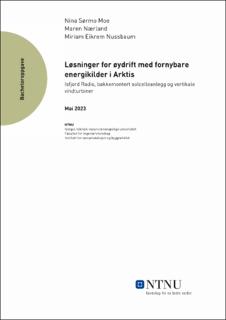| dc.contributor.advisor | Gebremedhin, Alemayehu | |
| dc.contributor.advisor | Christiansen, Sjur Narten | |
| dc.contributor.author | Moe, Nina Sørmo | |
| dc.contributor.author | Nærland, Maren | |
| dc.contributor.author | Nussbaum, Miriam Eikrem | |
| dc.date.accessioned | 2023-07-04T17:24:25Z | |
| dc.date.available | 2023-07-04T17:24:25Z | |
| dc.date.issued | 2023 | |
| dc.identifier | no.ntnu:inspera:148645808:148646858 | |
| dc.identifier.uri | https://hdl.handle.net/11250/3075903 | |
| dc.description.abstract | Oppvarmingen i Arktis har de siste 40 årene vært dobbelt så høy sammenlignet med resten av verden. Klimaendringene fører til lokale og globale konsekvenser for natur og dyreliv. Dette i kombinasjon med energiomleggingen på Svalbard stiller krav til fornybare energiløsninger. Denne oppgaven undersøker hvordan sol- og vindkraft i kombinasjon med batterilagring kan bidra til dieselreduksjon fra aggregat på Isfjord Radio.
Problemstillingene omhandler optimalisering av et bakkemontert solcelleanlegg med hensyn på unngåelse av snøakkumulering, batterilagring, VAWT, økonomisk vs. klimamessig lønnsomhet og FNs bærekraftsmål. De blir besvart basert på resultatene fra tre ulike scenarioer. Studien har en kvantitativ tilnærming der data består av utdelt materiale fra oppdragsgiver og offentlige kilder. Litteratur er hentet fra tidligere forskning og teori. For analyse ble programvarene PVsyst og MatLab benyttet.
For å unngå snøakkumulering bør solcellepanelene stå parallelt med vindretningen. Dette tilsvarer en asimutvinkel på -42 grader på Isfjord Radio. For scenario 1, bakkemontert solcelleanlegg på 198 kWp, er den mest optimale helningsvinkelen 20 grader. For scenario 2, scenario 1 med batterilagring, er den mest optimale helningsvinkelen 40 grader. For scenario 3, scenario 2 med vindkraft, vil installasjon av VAWT fungere som en komplementær bidragsyter for solkraft. Produksjonen bidrar til å dekke deler av forbruket i mørketiden.
Dieselforbruket på Isfjord Radio kan på det meste reduseres med 39 242 L/år, som tilsvarer et kutt i klimagassutslipp på 32,9 %.
Resultatene fra NNV viste at ingen scenarioer er økonomisk lønnsomme, men dersom det er mulig bør ikke økonomiske hensyn gå foran miljø- og samfunnsmessige gevinster. Resultatene indikerer at vind- og solkraft har positive innvirkninger på lokalt miljø og ren energiproduksjon. Dette bidrar til å nå bærekraftsmål 7 og 13. Likevel kan det gå på bekostning av bærekraftsmål 12 og 15. Fornybar energi kan negativt påvirke dyreliv og natur som ved arealbeslag og inngrep i jordsmonn. Sol- og vindkraft i Arktis krever innovative løsninger som «lukkede» VAWT og solcellepaneler løftet opp fra bakken. Omlegging til fornybar energi krever også ansvarlig forbruk og produksjon av komponenter. | |
| dc.description.abstract | The warming in the Arctic has been twice as high in the last 40 years compared to the rest of the world. Climate change leads to local and global consequences for nature and wildlife. This, in combination with the energy transition on Svalbard, requires renewable energy solutions. This thesis investigates how solar and wind power in combination with battery storage can contribute to diesel reduction from generators at Isfjord Radio.
The issues concern the optimization of a ground-mounted solar panel system with regard
to the avoidance of snow accumulation, battery storage, VAWT, economic vs. climaterelated profitability and the UN’s sustainability goals. They are answered based on the results from three different scenarios. The study has a quantitative approach where data consists of distributed material from the client and public sources. Literature is taken from previous research and theory. The software PVsyst and MatLab were used for analysis.
To avoid snow accumulation, the solar panels should be parallel to the wind direction. This corresponds to an azimuth angle of -42 degrees at Isfjord Radio. For scenario 1, groundmounted solar system of 198 kWp, the most optimal tilt angle is 20 degrees. For scenario 2, scenario 1 with battery storage, the most optimal tilt angle is 40 degrees. For scenario 3, scenario 2 with wind power, installation of VAWT will act as a complementary contributor to solar power. The production helps to cover part of the consumption during the polar night. Diesel consumption at Isfjord Radio can at most be reduced by 39,242 L/year, which corresponds to a cut in greenhouse gas emissions of 32.9 %.
The results from NNV showed that no scenarios are economically profitable. If possible,
financial considerations should not come before environmental and social gains. The results indicate that wind and solar power have positive impacts on the local environment and clean energy production. This contributes to achieving sustainability goals 7 and 13. Nevertheless, it may come at the expense of sustainability goals 12 and 15. Renewable energy can negatively affect wildlife and nature, such as land confiscation and soil encroachment. Solar and wind power in the Arctic requires innovative solutions such as “closed” VAWT and solar panels lifted from the ground. Conversion to renewable energy also requires responsible consumption and production of components. | |
| dc.language | nob | |
| dc.publisher | NTNU | |
| dc.title | Løsninger for øydrift med fornybare energikilder i Arktis | |
| dc.type | Bachelor thesis | |
